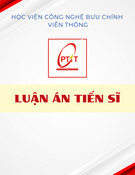M INISTRY OF EDUCATION AND TRAINING M INISTRY OF DEFENCE 108 IN STITU TE OF C LINI C A L MEDI C A L AN D P HA R MAC EU TI CA L SCI EN C ES
BUI QUANG BIEU RESEARCH ON18F-FDG PET/CT IMAGES IN POSTSURGICAL DIFFERENTIATED THYROID CANCER PATIENTS WITH HIGH SERUM THYROGLOBULIN AND NEGATIVE 131I WHOLE BODY SCAN Speciality: Diagnostic Imaging Code: 62.72.01.66
ABSTRACT OF MEDICAL PHD THESIS Ha Noi – 2020
THE THESIS WAS DONE IN:108 INSTITUTE OF CLINICAL MEDICA L AND PHA RMACEUTICAL SCIENCES
Supervisors:
1. Ass.Prof. PhD. Le Ngoc Ha 2. Ass.Prof. PhD. Lam Khanh
Reviewers:
1. 2. 3.
This thesis will be presented at Institute Council at: 108 Institute of Clinical Medical and Pharmaceutical Sciences Day Month Year The thesis can be found at:
1. National Library of Vietnam 2. Library of 108 Institute of Clinica l Medica l and Pharmaceutical Sciences 3. Central Institute for Medical Science Infomation and Tecnology
1 ĐẶT VẤN ĐỀ
The incidence of thyroid cancers has been increasing in recent
thyroid carcinomas ranks the ranks
years. In Vietnam, the 6thcommon cancers in female. Differentiated thyroid cancers (DTC) including papillary carcinoma, folicullar carcinoma and Hurthle cell
After thyroidectomy and radioactive carcinima account for more than 90% of all thyroid cancers. iodine (RAI)
therapy, thyroglobulin (Tg) is considered the tumor markerand iodine-131 (131I) whole body scan (WBS) is the specific image in follow-upand detection of recurrent/metastatic DTC. However, in clinical practice,
there were 2 – 15% postsurgical DTC patients withhigh serum Tg (> 10 ng/ml)which suggested recurrence/metastasis but negative 131I WBS.
Several studies in the world have demonstrated the diagnostic values of 18F-FDG PET/CT in detecting recurrence/metastasis in postoperative 131I WBS DTC patients withhigh serum Tg and negative withsensitivity and specificity ranged from 82 to 95%.
In Vietnam, there still have been few researches on this issue. Therefore, weperformed the study“Research of 18F-FDG PET/CT images in postsurgical differentiated thyroid cancer patients with high serum thyroglobulin and negative 131I whole body scan”with two objectives:
1. To
investigate clinical, paraclinical and 18F-FDG- PET/CTimaging characteristics of postsurgical differentiated
therapy with high serum
thyroid cancerpatients post RAI thyroglobulin and negative 131I whole body scan.
2. To determine the diagnostic values of 18F-FDG-PET/CT in postsurgical differentiated thyroid cancer patients post RAI therapy with high serum thyroglobulin and negative 131I whole body scan.
2 Chapter 1 OVERVIEW
1.1. Management of postsugical DTC patients post RAI therrapy with high Tg and negative 13 1I WBS
According to NCCN and ATA Guidelines, strategies
for management of DTC patients with high Tg and negative 131I WBS are summarised in the diagram below.
Postsurgical and post RAI therapy DTC patients
Tg> 10 ng/ml Negative13 1IWBS
*To evaluate invassive lesions or if PET/CT is not available
Neck ultrasound
18F-FDG PET/CT
CT, MRI
Negative Positive
TSH suppression Follow-up No symptoms With symptoms, progression Emirica lRAI therapy
Local therapy TKIs
EBRT RFA, PEI Surgery
TKIs: tyrosine kinase inhibitors; EBRT: external beam radiotherapy; RFA: radiofrequency ablation; PEI: percutaneous ethanol injection) Management of DTC patients with high Tg and negative 131IWBS
3 1.2.18F-FDG PET/CT in postsurgical DTC patients with high Tg and negative 131I WBS
The applications of Positron Emission Tomography (PET) have
been developed for more than 40 years since it’s invention.From 1970’s, PET had been used for studies in cardiac and neuro diseases.
One decade later, the researchers also noted that PET was a valuable
diagnostic tool in oncology. Not likeother structure and anatomy based diagnostic methods such as computed tomography (CT) or
magnetic resonance imaging (MRI), PET records qualitative and
quantitative images of physiopathological and metabolic process of diseases via labelled pharmaceutical isotopes. The combination of
PET and CT in one system PET/CT allowed optimal exploitationof
the advantages of both PET (metabolic informations of tissues) and CT (structural changes and localization of les ions).
Currently, the most common pharmaceutical isotope used in PET scan was 18F-FDG (18F-2-fluoro-2-deoxy-D-glucose), an analogue of glucose(replacement of the 2nd hydrogen atom in the glucose moleculewith fluor-18(18F). 18F-FDG is transfered into cells via glucose transpoters in membrane.18F-FDG is phosphorylated to become 18F-FDG-6-phosphate and is accumulated inside cells because it cannot be metabolised or deposited in the form of glycogen like glucose. 18F-FDG uptake in malignant cells is mainly due to the increase of glucose transporter (especially GluT-1) in cell
membrane and hexokinase such as HK-II...
Due to the decreasing of natri/iodine symmporter (NIS) and increase of glucose transpoter (GLUT) in cell membrane, 18F-FDG in diagnosis of recurrence, PET/CT plays an important role
in
4 metastasis and change of treatment strategy in postsurgica l DTC with high serum Tg and negative 13 1I WBS. 1.3. Studies about diagnostic value of 18F-FDG PET/CT postsurgical DTC with high Tg negative131I WBS 1.3.1. Foreign studies
The main application of 18F-FDG PET/CT in postsurgica l DTC is to localize recurrent and metastatic lesions in patients with high serum Tg (Tg > 10 ng/ml) and negative 13 1I WBS. Numerous foreign studies have shown that the average sensitivity and specificity of 18FDG PET/CT in diagnosis of recurrence and metastasis in postsurgical DTC with this condition were 83% (50 –
100%) and 84% (42 – 100%), respectively.
Several foreign studies also demonstrated that 18F-FDG PET/CT had changed the treatment plan in 44 – 78.4% of DTC patients with high serum Tg and negative 13 1I WBS. 1.3.2. Studies in Vietnam
There were very few researches about the diagnostic value of 18F-FDG PET/CT in DTC with high serum Tg and negative 13 1I WBSin Vietnam. A study from Le Ngoc Ha et al (2016) showned that the sensitivity, accuracy and negative predictive value of
PET/CT were 88%; 87% and 76%, respectively.The best SUVmax
threshold for diagnosis was 4,5 with sensitivity 92.3% and specificity 100%. PET/CT also changed treatment strategy in 47,8% of patients.
However, most of those studies had limited number of patients
and did not fully evaluate the imaging characteristics as well as values of 18F-FDG PET/CT in postsurrgical DTC with high serum Tg and negative 13 1I WBS.
5 Chapter 2 SUBJECTS AND METHODS
2.1. SUBJECTS
109 DTC patients whom were followed up and treated in
Department of Nuclear Medicine, 108 Military Central Hospital from
5/2010 to 12/2018 2.1.1. Selection criteria
- Postsurgical and post RAI DTC patients (papillary, follicular,
follicular variant of papillaryand Hurthle cell thyroid carcinomas). - Serum Tg > 10 ng/ml after TSH stimulation(TSH ≥ 30 µUI/ml) and negative13 1I WBS. - A-Tg < 115 UI/ml. - Patients who agree to participate in the study.
2.1.2. Exclusion criteria
- Patients with second primary tumor apart from thyroid cancer. - Patients cannot cooperate to undergo PET/CT scan. -18F-FDG PET/CT images cannot be analysed. 2.1.3. Research site: Department of Nuclear Medicine, 108 Military Central Hospital.
2.2. METHODS
2.2.1. Study design:a cross-sectional descriptive, prospective study. 2.2.2. Radiopharmaceuticals, research tools and equipments
Radiopharmaceuticals
-Liquid of13 1I (Egis Pharmaceutical – Hungary)or 131I capsule (Samyoung, South Korea and Pharmatopes, Australia). - 18F-FDG produced atNational Cyclotron Center, 108 Military Central Hospital.
6
Research tools and equipments
- Roche Diagnostics Elecsys 2010 (Switzerland).
- GE gamma camera Milenium and Infinia (USA).
- Philips EPIQ 5 ultrasound (Holland). - GE PET/CT Discovery LightSpeed (USA).
2.2.3. Research protocol
- Patients were thoroughly examined: hisptory, physical check up, medical record review, purpose of the study and research protocol, 18F-FDG PET/CT scan protocol, treatment and follow up schedule. - Diagnosis of DTC was based on histopathology findings. - Postoperative and post - RAI therapy restaging, before18F-FDG PET/CT scan according to AJCC 7 (2010).
- Patients were instructed to withdraw from thyroid hormon (4 weeks for T4 or 2 weeks for T3), undergo iodine restricted diet for 2 weeks
before diagnostic WBS and RAI therapy.
- Serum Tg, A-Tg, TSH test(TSH level must be greater than 30 µUI/ml). - Neck ultrasound was performed by several physicians following a
standard protocol before PET/CT scan to evaluate neck lymphnode and
thyroid bed lesions. - Patients underwent diagnostic WBSafter taking 5 mCi 131I orally 48 hours.Post-therapy WBS scan was performed 5 – 7 days after RAI
therapy. - All patients underwent whole body 18F-FDG PET/CT scan. Head and neck dedicated PET/CT scan was performed in 84 patients
during TSH stimulation (immediate ly when negative WBS was determined) or when TSH was not stimulated (2 – 3 months post
negative WBS).
- Number of cervical lesions (cervical lymphnodes, thyroid bed lesions)
7 detected by neck ultrasound, whole body PET/CT, and head and neck dedicated PET/CT were compared.
- Diagnostic values of PET and PET/CT, whole body PET/CT and head
and neck dedicated PET/CT were compared. - Most suitable SUV threshold for diagnosis of recurrent/metastatic
thyroid cancer was determined.
- Patient management protocol post PET/CT scan was as follows:
+ Patients were discussed at thyroid tumor board meeting to decide
the suitable treatment after finding lesions in PET/CT: (1) surgery,
radiation therapy for localized lesions;(2)chemotherapy and targeted therapy for progressive and multiple lesions, (3) empiric RAI therapy,
TSH suppression and follow-up for small and slow-growing lesions.
+ If PET/CT results were negative, patients could be considered
to undergo empiric RAI therapy or TSH suppression and follow-up.
- Routine follow-up protocol after PET/CT scan was as follows:
+ Patients were scheduled for checkup 6 months post PET/CT scan: physical examination, serum Tg and A-Tg testing, neck
ultrasound, FNA, CT scanas required.
+ If no recurrence/metastasis of thyroid cancer, patients were
appointed for checkup every 6 months.
+ If recurrence/metastasis of thyroid cancer were detected,
patients would undergo consultation at thyroid tumor board meeting to decide the suitable treatment.
2.2.4. Technical procedures:
- Serum Tg was tested in Elecsys 2010 (Roche) at Department of Biochemistry, 108 Military Central Hospital.
- Neck ultrasound was performed in Phillips EPIQ by several
physicians following a standard protocol.
8 - 131I WBS was performed in GE Milenium and Infinia gamma camerafollowing the Society of Nuclear Medicine Guidelines (USA).
- Whole body PET/CT scan was performed in GE PET/CT
the Society of Nuclear Medicine
DiscoveryLightSpeed following Guidelines (USA).
- 84patients underwenthead and neck dedicated PET/CT
scanfollowing the Duke University Hospital protocol after whole body PET/CT.
2.2.4.Criteria use d for evaluation in the study
- Patient clinical characteristics:
+ Age: 2 age groups< 45 and≥ 45.
+ Gender: male and female.
+ Histopathology: papillary, follipapillary and follicular carcinomas.
- High serum Tg level: > 10 ng/ml with TSH stimulation.
- Serum Tg level classification: mean, median, and quartile. - 131I WBS interpretation:
+ Negative: no abnormal focal 13 1I uptake. + Positive:when abnormal focal uptakes at thyroid bed, cervical
lymph node, lung… were notified, apart from physical normal uptake. - TNM restagingaccording to AJCC 7 postsurgical and before
PET/CT scan.
- Neck untrasound interpretation:
+ Recurrence at thyroid bed: hypoechoic nodule,size > 6 mm with
marginal spiculation, peripheral hypervascularity.
+ Suspected cervical lymphnodes with at least one feature: round shape, abscene of an echogenic hilum, microcalcifications,
hyperchogenicity, cystic change, peripheral flow. - Follow up after 18F-FDG PET/CT scan:number of patients
9
identified with recurrence, metastasis. - Evaluation of lesions in low dose whole body CT and head and neck dedicated CT of 18F-FDG PET/CT:
+ Recurrence at thyroid bed: suspected when short axis ≥ 1 cm,
marginal irregularity, calcification.
+ Suspected metastatic cervical and mediastinal lymphnodes with
at least one feature:short axial diameter≥ 1 cm, round shape, irregular margin, extracapsular spread, central necrosis, three or more
contiguous lymphnodes in drainage chain of the tumor.
+ Suspected metastatic
in other sites: soft tissue lesions attenuation, well circumscribed, rounded les ions, often in the
18F-FDG PET and PET/CT results were interpreted by two
periphery of the lung;lytic, sclerotic or mixed bone lesions.
- nuclear medicine physicians according to Shammas S (2007):
+ Positive: when abnormal focal FDG uptakes are identified.
+ Abnormal FDG uptakes which correspondedto abnormal
lesions in CT are considered as recurrence or metastasis.
+ FDG uptakes which not related with corresponding structures in
CT of PET/CT are considered positive.
+ Lesions in CT which not related to abnormal FDG uptakes are
considered positive if they have these characteristics: contrast
enhancing, abscene of lymph node fatty hilum, lymph node with necrosis, lung nodule. - 18F-FDG PET/CT results were compared with recurrent, metastatic status identified during follow-up post PET/CT scan: postsurgical histopathology results, neck ultrasound, CT, serum Tg. They are gold
standard to define the diagnostic values of PET/CT. - Quantity, location and SUVmax of les ions found in 18F-FDG
10
PET/CT were evaluated. - Numbers and rates of recurrence, metastasis in cervical lymph node, thyroid bed and distant metastasis found in 18F-FDG PET/CTwere also evaluated. - Calculate diagnostic values of PET, whole body PET/CT and head
and neck đeicated PET/CT: sensitivity, specificity, accuracy,
predictive positive value, predictive negative value, false positve and negative rates.
Diagram 2.1. Study design
2.3. Data analysis
11
Data were collected and analysed by SPSS software
version18.0 for Windows.
Chapter 3 RESEARCH RESULTS
3.1. Patient and 18F-FDG PET/CTimaging characteristics 3.1.1.Patient characteristics
- 109 patients recruited including 81 females and 28 males, femal/male ratio≈3/1, mean age 45.7 ± 14.9. - Histopathology type: mainly papillary thyroid carcinoma
93,6%,follicular variant of papillary- thyroid carcinoma 6.4%. - TNM stage: stage I 56,9%, stage II and III only 1.8% and 0.9%;
stage IV 37.6%; not identified 2.8%. - Average number of RAI and 131I total cumulative dose before PET/CT scan were 3.13 treaments and 418.8 mCi, respectively.
3.1.2. Lab test characterisitcs Table 3.9. Serum Tg, A-Tg, TSH levels before PET/CT scan
Minimum Maximum Median Mean ± SD 20.5 1000 Level Tg (ng/ml) 217
23.6 100 297.9 ± 250.0 25.7 ± 11.6 86 ± 20.1 10 31.1 61.5 101 A-Tg (UI/ml) TSH (µUI/ml)
Remarks:
Serum Tg levelshad a wild range with the median of 217 ng/ml
and meanvalueof 297,9 ng/ml.
12
Table 3.11. Neck ultrasound results before PET/CT scan
Number (n) Characte ristics
Res ults
Les ions’ site
Percentage (%) 62.4 37.6 3.3 0 25 18.3 40.8 1.7 10.8 100 Positive Negative Thyroid bed Cervical LN level I Cervical LN level II Cervical LN level III Cervical LN level IV Cervical LN level V Cervical LN level VI Sum 68 41 4 0 30 22 49 2 13 120
Remarks:
- Positive neck ultrasound was in 62.4% of patients. - 120 lesions were noted in nek ultrasound: mostly was
lymphnodes in level IV (40.8%), then lymph nodes in levelII l
(25%), level III (18.3%), level VI (10.9%) and the least was lesions in thyroid bed (3.3%) andlevel V lymphnodes (1.7%). 3.1.3. 18F-FDG PET/CT imaging characteristics
Table 3.12. Number of lesions found in PET và PET/CT Modality PET PET/CT p Number of les ions
0.007 272 3.36 ± 2.39 (1 – 13) 294 3.46 ± 2.41 (1 – 13) Total Mean (Range)
13
Remarks:
Mean number of lesions found in PET/CT was 3.46 lesions
significantly higher than that found in PET (3.36 lesions).
Table 3.13. Compare the number of lesions found in PET and PET/CT according to lesion site
Number of les ions PET/CT finfing more than PET PET PET/CT
159 45 35 20 5 8 272 173 46 35 27 5 8 294 n 14 1 0 7 0 0 22 % 8.8 2.2 0 35 0 0 8.1
Les ion site Cervical lymph node Mediastinal lymph node Thyroid bed Lung Bone Other sites Total of lesions
Remarks:
- Cervical lymph node was most the lesion found in PET và PET/CT, then lesions in mediastinal lymph node, thyroid bed, and lung.
- PET/CT found more than PET 22 lesions (8.1%) including: 14 cervical
71 65.1%
34 31.2%
29 26.6%
80 60 40 20 0
Distant metastasis
Cervical node metastasis
Thyroid bed
node (8.8%), 1 mediastinal lymph node (2.2%), and 7 lung lesions (25%).
Chart 3.7. Rates of recurrence, metastasis found in PET/CT
14
Remarks:Cervical node metastasis was most found in PET/CT in 71 patients (65.1%), then distant metastasisin 34 patients (31.2%)
and the lowest rate was lesion in thyroid bedin 29 patients (26.6%).
Table 3.19. Compare the number of lesions found in neck ultrasound and whole body PET and withhead and neck dedicated PET/CT Head and neck Number of les ions dedicated PET/CT finding more than whole body PET Les ion site Neck ultraso -und Whole body PET Head and neck dedicated PET/CT
126 31 157 137 31 168 n 11 0 11 % 8.7 0 7.0 Cervical lymph node 91 3 Thyroid bed 94 Total number
Remarks:
- Head and neck dedicated PET/CT found 74 lesions more than neck ultrasound including 46 cervical nodes and 28 les ions in thyroid bed.
- Head and neck dedicatedPET/CT found 11 les ions (8,7%) more
than whole body PET.
Table 3.20. Lesion characteristics in PET/CT
Value Characte ristics n %
14,0 ± 8,4 (3 – 58) Mean lesion size (mm) (Range)
Classification of les ion size
3 48 212 31 294 1.0 16.4 72.1 10.5 100 < 5 mm 5 - 9 mm 10 - 19 mm ≥ 20 mm Total
Remarks:
- Mean lesion size in PET/CT was 14 mm.
15 - Lesion size 10 – 19 mm had the highest rate of 55.9%, then lesion size 5 – 9 mm (16.4%), lesion size≥ 20 mm (10.5%) and the lowest
rate was lesion size < 5 mm (1%).
Table 3.21.Characteristics of lesion’s SUVmax in PET/CT
Value Characte ristics % n
9.3 ± 7.3 (2.5 – 64) SUVmax (g/ml) (Range)
SUVmax subgroup
< 5 g/ml 5 – 9.9 g/ml 10 – 19.9 g/ml ≥ 20 g/ml Total 2722 40.8 24.8 7.2 100 80 120 73 21 294
Remarks:
- Mean SUVmax of lesions in PET/CT was 9.3 g/ml.
100%
80%
81 74.3%
85 78%
60%
Pos itvie
Negative
40%
20%
28 25.7%
24 22%
0%
PET
PET/CT
- Lesions with SUVmax 5 – 9,9 g/ml had the highest rate 40.8%, and the lowest rate was ones with SUVmax > 20 g/ml (7.2%). 3.2. Diagnostic values of 18F-FDG PET/CT in differentiated thyroid cancer with high Tg and negative 131I whole body scan
16 Chart 3.11.Results of 18F-FDGPET and PET/CT Remarks:PET/CT results were positive in85 patients (78%) higher
than that of PET (positive in 81 BN; 74.3%).
Table 3.29. Follow-up time and results post PET/CT scan (n = 109) % n 35.9 ± 20.6 12 - 89 Follow-up time and res ults Mean± SD Range Follow-up time (months)
57 52.3
Yes 28 25.7 Follow-up res ults Recurrence, metastatis Postsurgical histopathology Clinical, lab and test follow-up 24 22.0 No
Remarks:
- Patients’s mean follow-up time post PET/CT scan was 35.9 months.
- Recurrence/metastasis was identified in 85 patients (78%), 24 patients (22%) had no recurrence, metastasis during follow-up time.
Table 3.30. ComparePET and PET/CT results with follow-up results post PET/CT scan(n = 109) No Yes Recurrence/ metastasis p % n % n Modality
<0,001 PET
<0,001 PET/CT 6 18 6 18 7.4 64.3 7.1 75 92.6 35.7 92.9 25 Positive Negative Positive Negative 75 10 79 6
Remarks:
- PET results showed that 6/81patients (7.4%) were false positive and 10/28 patients (35.7%) were false negative.
17 - PET/CT results showed that 6/85 patients (7.1%) were false positive and 6/24 patients (25%) were false negative.
Table 3.31.Diagnostic values of PET and PET/CT in detection of recurrent/metastatic thyroid cancer (n = 109)
Modality PET PET/CT
88.2 75 92.6 64.3 25 11.2 85.3 Value Sensitivity (%) Specificity (%) Positive predictive value (%) Negative predictivevalue (%) False positive rate (%) Falsenegative rate (%) Accuracy (%) 92.9 75 92.9 75 25 7.1 89
Remarks:
- PET/CT had 92.9% sensitivity, 75% negative predictivevalue and 89%
accuracy, higher than that of PET (88.2%; 64.1% and 85.3%, respectively). - False positve rate of both PET/CT and PET were 25%. False
negative rate of PET was 11.2% higher than that of PET/CT (7.1%).
Table 3.33. Compare the diagnostic values of head and neck dedicated PET/CT and whole body PET/CT (n = 84) Protocols
Head and neck dedicated PET/CT Whole body PET/CT
Diagnostic values Sensitivity (%) Specificity (%) Positive predictive value (%) Negative predictive value (%) False positive rate (%) Falsenegative rate (%) Accuracy (%) 93.7 76.2 92.2 80 23.8 6.3 89.3 90.9 66.7 95.2 50 33.3 9.1 88
18
Remarks: - Head and neck dedicated PET/CT had 93.7% sensitivity, 76.2%
specificity, 80% negative predictive value and 89.3% accuracywhich
were higher than that of whole body PET/CT (90.9%; 66.7%; 50% and 88%, respectively).
- Whole body PET/CT had 95.2% positive predictive value, 33.3%
false positive rate and 9.1% false negative rate, which wre higher
than that head and neck dedicated PET/CT.
Chart 3.13. Analysis of ROC of SUVmax in diagnosis of
recurrent/metastatic thyroid cancer Remarks:Via analysis of ROC, SUV threshold of 5.6 g/ml was
determined as the optimal value for diagnosis of recurrent/metastatic
thyroid carcinoma with 84% sensitivity and 83.3% specificity.
19
Chapter 4 DISCUSSION
4.1. Patient and 18F-FDG PET/CTimaging characteristics 4.2.1. Patient characteristics
In this study, patient’s mean age was 45.7 years. Our result was
similar to results of Na SJ (2012) and Bannas P (2012)but lower than
results of other authors.The female/male ratio in our study was 3/1 higher than the ratios in other studies.The reason for this may be the
equivalence or difference of study sample, geographic and
socioeconomic conditions.
In our study, patient’s median and mean off-T4 serum Tg levels
and pre-PET/CT scan were 217 ng/ml and 297.9 ng/ml, respectively.
Mean Tg level of patients in our study was higher than most of other studies, may be because of difference in patient’s characteristics
between studies. The higher the Tg level, the more possibility of
recurrent, metastatic thyroid cancer. 4.2.2. 18F-FDG PET/Ct imaging characteristics
Number and site of lesions
294 lesions were found in PET/CT, more than that found in PET (272 lesions)(Table 3.12). When comparing the number and
percentage of lesions, PET/CT detected more than PET 22 lesions
(8.1%) (Table 3.13). This result showed the advantage of PET/CT to PET alone due to the combination of metabolic and functional
information in PET and the anatomical information in CT.
About les ion site, cervical lymph node was the most lesion
20 detected in both PET/CT andPET. PET/CT discovered more lesions cervical lymph node and thyroid bed than PET did (Table 3.13).
May be patients with thyroid cancer had already undergone surgery
in neck region that caused the anatomical change so it is difficult for PET only to identify small les ions. Besides that, some suspected
lesions in CT did not uptake FDG in PET, so that low dose whole
body CT and head and neck dedicated CT would supplement anatomical information for PET and help to evaluate lesions more
accurately.
Recurrence, metastasis detected in PET/CT
About the rate of recurrence, metastasis detected in PET/CT,
node metastasis accouted for the highest rate 65.1%, then distant
metastasis 31.2% and recurrence in thyroid bed 26.6% (Chart 3.7). Our result was similar to Chung JK’s results (1999) in South Korea
with lesions most found in PET were cervical nodes (87.9%), then
mediastinal lymph nodes (33.3%), lung (27.3%) andbone (9.1%).The ability to discover distant metastasis is an advantage of PET/CT to
conventional diagnostic imaging modalities such as ultrasound, CT
and MRI.
Lesion’s size and SUVmax
Mean lesion’s size in PET/CT was 14.0 mm, there were 3
lesions< 5 mm (1%) and 48 lesions w ith size from 5 – 9mm (16.4%) (Table 3.20). This results showed the advantage of PET/CT in
detecting small recurrent/metastatic lesions in patients with thyroid
cancers. It is because PET/CT combined both the abilities of metabolic diagnosis in PET and anatomic diagnosis in CT.
The mean lesion’s SUVmax was 9.3 g/ml. (Table 3.21). Our
result was higher than that of Iagaru A (2007), Na SJ (2012) và Ha
21 LN (2016). The difference may be due to the mean serum Tg level in our study was higher than the ones in the studies above and the
difference of PET/CT units and scan protocols between centers . 4.2. Diagnostic values of18F-FDG PET/CT in differentiated thyroid cance r patients with high se rum Tg and negative whole body13 1I scan 4.2.1.
18F-FDG PET/CT results
Studies around the world showed that the rates of positive PET
ranged from 43.5 - 76% and the rates of positive PET/CT ranged
from 49.1 - 80%. The rates of positive PET and PET/CT in our study were higher than that of other authors may be due to the higher mean
serum Tg levelof patients in this study (Chart 3.11). Stangiersky A
(2013) noted that the rate of positive PET/CTwas 20.3% higher than that of PET beacause low dose whole body CT detected more lesions
that did not uptake FDG in PET. 4.2.2. Diagnostic values of 18F-FDG PET/CT
Diagnostic values of PET/CT for recurrent, metastatic
thyroid cancer
In this study, the diagnostic values of PET/CT were as follow: sensitivity 92.9%, specificity 75%, positive predictive value 92.9%,
negative predictive value 75%, fale positive rate 25%, false negative
rate 7.1% and accuracy 89% (Table 3.31). Our results were similar to that of Vural GU but lower than that of Palmedo H, Giovanelly L,
Ha LN and higher than that of Shammas S, Na SJ. It may be due to
the differences in patients’ characteristics and criteria for evaluation between studies.
When compared the diagnostic values of PET/CT and PET in
detection of recurrent/metastatic thyroid cancers, we noted that
22 PET/CT had higher sensitivity, negative predictive value and accuracy than PET. However, false negative rate of PET/CT was lower that of
PET (Table 3.31). This results demonstrated the supplementary role of
low dose whole body CT in providing anatomical information to PET. Our results were partly similar and partly different to that of Palmedo
H (2006) and Freudenberg LS (2007).
Compared the diagnostic values of head and neck
dedicatedPET/CT and whole body PET/CT
Combined head and neck dedicated PET/CT with whole body
PET/CT had not only increased sensitivity, specificity, negative predictive value, and accuracy but also decreased false positive
rate,false negative rate in diagnosis of recurrent, metastatic thyroid
cancers in this study (Table 3.33). Theresults reaffirm the important complementery role of head and neck dedicated PET/CT protocol to
whole body PET/CT to help increase the diagnostic quality in
differentiated thyroid cancer patients with high serum Tg and negative I 13 1Iwhole body scan.
Determined the optimal SUVmax threshold in PET/CT result
analysis
Via ROC analysis, we found that optimal SUVmax threshold
for diagnosis of recurrent/metastatic thyroid cancers in PET/CT was
5.6 with corresponding sensitivity and specificity of 84% and 83.3%, respectively. (Chart 3.13). Some other authors via ROC analysis
also determined lower SUVmax threshold than our study. Giovanelly
(2012), Kunawudhi A (2012), Ha LN (2016)chosen the SUVmax of 4.6; 2.75 and 4.5, respectively for diagnosis ofrecurrent, metastatic
thyroid cancers.
23
CONCLUSION
1. Patient and 18F-FDG PET/CT imaging characteristics 1.1. Clinical, lab test characteristics
- Patient’s mean age was 45.7 ± 14.9; female/male ratio was≈ 3/1. Histopathology type: mainly papillary thyroid carcinoma 93,6%,
follicular variant of papillary- thyroid carcinoma 6.4%.
- TNM staging: mainly stage I 56,9%, stage II and III only 1.8% and 0.9%; stage IV 37.6%; not identified 2.8%.
- Median and mean serum Tg levels were 217 và 297.9 ng/ml,
respectively. 1.2. 18F-FDG PET/CT imaging characteristics - PET/CT detected 294 lesions in 85 patients,22 les ions (8.1%)
more than that detected in PET including: 14 cervical lymph nodes (8.8%), 1 mediastinal lymph nodes (2.2%) and 7 lung lesions (25%).
- The rates of lesions in thyroid bed, lymph node metastasis, distant
metastasisdetected in PET/CT were 26.6%, 65.1% and 31.2%, respectively.
- Head and neck dedicated PET/CT discovered 11 cervical lymph
nodes (8.7%) more than whole body PET did. - Mean size and SUVmax of lesions in PET/CT were 14 ± 8.4 mm
and 9.3 ± 7.3 g/ml. 2. Diagnostic values of 18F-FDG PET/CT - The rate of patients withpositive PET/CT resultswas 78% higher
than that of positve PET results (74.3%).
- Sensitivity, accuracy of PET/CT in diagnosis of recurrent,
24 metastatic thyroid cancer were92.9% and 89%, respectively, higher than those of PET (88.2% and 85,3%, respectively). Specificity of
both PET/CT and PET were 75%.
- Head and neck dedicated PET/CT had higher sensitivity(93.7%), (80%), specificity predictive (76,2%), negative value
accuracy(89.3%) butlowerpositive predictive value(23.8%), false
negative rate (6.3%)thanwhoel body PET/CT (corresponding values were 90.9%; 66.7%; 50%; 88%; 33.3% and 9.1%, respectively).
- The optimal SUVmax threshold for diagnosis of recurrent,
metastatic thyroid cancers in the study was 5.6 g/ml with sensitivity and specificity were 84% and 83.3%, respectively.
PROPOSALS
Based on the research’s results, we might have some proposals
as follow:
1. Head and neck dedicated PET/CT protocol should be considered in combination with whole body18F-FDG PET/CT in differentiated thyroid cancer patients with highserum Tg level and negative 13 1I whole bodyscan to improve the detection of recurrent, metastatic lesions in cervical regions.
2. SUVmax 5.6 should be considered as the diagnostic threshold to analyse 18F-FDG PET/CT results in differentiated thyroid cancer patients with highserum Tg level and negative 13 1I whole bodyscan.
LIST OF PUBLISHED PAPERS RELATED TO THE THESIS
1. Mai Hong Son, Bui Quang Bieu, Le Ngoc Ha (2016). Value of dedicated head and neck 18F-FDG PET/CT protocol in detecting
recurrent and metastatic lesions in post-surgical differentiated
thyroid carcinoma patients with high serum thyroglobulin level and negative 131I whole-body scan. Asia Oceania J Nucl Med
Biol, 4(1), 12-18.
2. Bui Quang Bieu, Le Ngoc Ha, Lam Khanh (2019). Imaging
characteristics and diagnostic value of 18F-FDG PET/CT in post-
operative differentiated thyroid cancer patients with elevated serum thyroglobulin and negative 131I whole body scan. Journal
of 108 Clinical Medicine and Pharmacy, 14(3), 105-13.
3. Bui Quang Bieu, Le Ngoc Ha, Lam Khanh (2019). Clinical characteristics of post-operative differentiated thyroid cancer
patients with elevated serum thyroglobulin and negative 131I
whole body scan. Journal of 108 Clinical Medicine and Pharmacy, 14(4), 8-15.


























